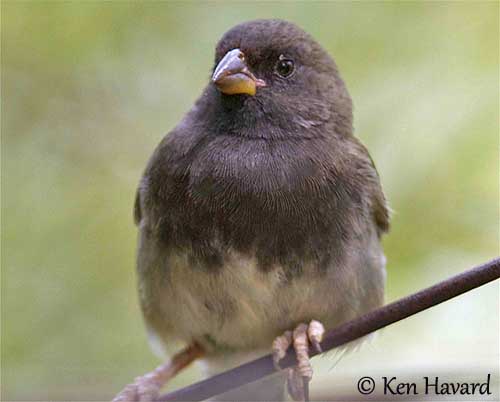
Fr: Sporophile cici
Ang: Black-faced Grassquit
All: Jamaikagimpelfink
Esp: Semillero Biocolor - Gorrión negro (Puerto Rico)
Ita: Fringuello cantore faccianera
Nd: Maskergrondvink
Sd: Västindisk frösparv
Photographers:
Alfredo Colón
Puerto Rico Wildlife
Ken Havard
My Bird Gallery & Flickr gallery 1 & Flickr gallery 2
Jean-Claude Jamoulle
A la rencontre des Oiseaux
Text by Nicole Bouglouan
Sources:
HANDBOOK OF THE BIRDS OF THE WORLD Vol 16 by Josep del Hoyo- Andrew Elliot-David Christie – Lynx Edicions – ISBN: 9788496553781
A GUIDE TO THE BIRDS OF COLOMBIA by Steven L. Hilty and William L. Brown - Princeton University Press – ISBN 069108372X
BirdLife International (BirdLife International)
Neotropical Birds – Cornell Lab of Ornithology
Wikipedia, the free encyclopaedia
What Bird-The ultimate Bird Guide (Mitchell Waite)
BREEDING THE BLACK-FACED GRASSQUIT Tiaris bicolor omissa, WITH SOME NOTES ON BEHAVIOUR - By Robin Restall
Black-faced Grassquit
Tiaris bicolor
Passeriformes Order – Thraupidae Family
INTRODUCTION:
The Black-faced Grassquit is part of the clade of the specialized tanagers like the Bananaquit and the Yellow-faced Grassquit (among several other species). This group includes several Caribbean genera and the Darwin’s Finches.
The Black-faced Grassquit feeds primarily on grass seeds and has thick, small and very short bill, well-adapted to this feeding behaviour.
DESCRIPTION OF THE BIRD:
Biometrics:
Length: 10-12 cm
Weight: 7-12 g
The adult male of nominate race has black head, throat and most of underparts. The rear part of the flanks is greenish-olive like upperparts, upperwing and tail.
The short, thick bill is blackish. During the breeding season, the gape becomes bright pink to red. The eyes are dark brown. Legs and feet are flesh-coloured.
The female is dull olive-green with browner or greyer tinge on the underparts. Her bill has dark upper mandible and pale lower mandible.
The juvenile resembles female.
SUBSPECIES AND RANGE:
The Black-faced Grassquit has 8 recognized subspecies.
T.b. bicolor (here described) occurs in Bahamas Islands, and NW of Isabela de Sagua, off N Cuba.
T.b. marchii (displayed) is found in Jamaica, Hispaniola and adjacent small islands.
In this race, the male has only the upper half of the underparts black.

T.b. omissus (displayed) occurs in Puerto Rico, Lesser Antilles to Tobago (not Trinidad), and mainland from N Colombia and E through coastal Venezuela.
This one resembles nominate but it is smaller.
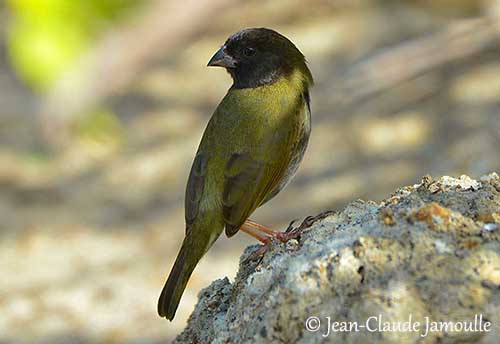
T.b. grandior occurs in San Andrés Archipelago in SW Caribbean.
This race resembles “omissus” but it is much larger with brighter olive-green upperparts.
T.b. sharpei is found in Netherland Antilles.
This race is paler.
T.b. tortugensis is found on Isla La Tortuga, off N Venezuela.
This race is paler than “sharpei” with greyish-olive upperparts.
T.b. johnstonei occurs on La Blanquilla and Los Hermanos, off N Venezuela.
This one is the blackest race with brighter olive-green upperparts than nominate.
T.b. huilae occurs in Magdalena Valley in C Colombia.
This race has paler brownish-olive upperparts, with brighter wings and tail than nominate.
HABITAT:
The Black-faced Grassquit can be seen in open or semi-open areas, in long grass or shrub, roadsides and ricefields. It also occurs in forest clearings, cactus scrub, plantations, gardens and urban areas.
According to the range, it can be seen from sea-level to 860 metres of elevation.
CALLS AND SONGS: SOUNDS BY XENO-CANTO
The Black-faced Grassquit’s call is a soft “tsip”. The song is a weak buzzing “tsee-tsee-tsee-seeseesee”. This song is usually given during the courtship displays.
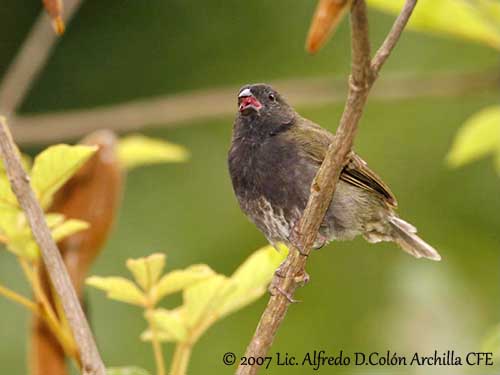
BEHAVIOUR IN THE WILD:
The Black-faced Grassquit feeds primarily on seeds of grasses and weeds, and often forages on or near the ground in grassy lawns and fields. But is may feed at treetops, nipping off buds and flowers. It also feeds on its favourite little nodules in Cecropia trees, and occasionally takes the fruits of Lemaireocereus cactus.
This species usually occurs alone or in pairs, but small groups can be formed around abundant food sources.
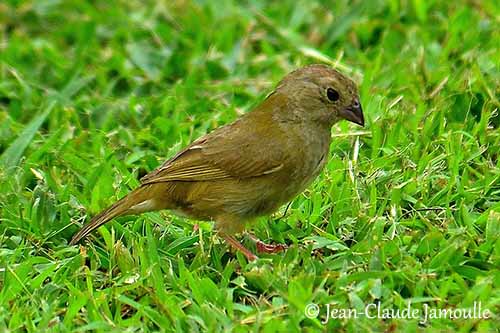
T.b. omissus
Female
During the breeding season, displays are observed. The male slightly drops its wings in front of the female. The bill is wide open and we can hear an explosive buzzing song. If the male perches higher than the female, this display is accompanied by a short display flight. It will “parachute” towards her with vibrating wings, while uttering a short part of the buzzing song.
They are monogamous and breed in small colonies. The birds become territorial and defend the territory at the beginning of the breeding season.
The Black-faced Grassquit is resident in its range. Some limited dispersions are recorded.
This species performs a weak fluttering flight with rapid wingbeats interspersed with wings pulled in to sides.
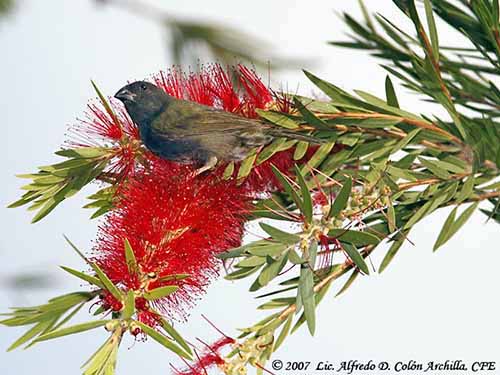
REPRODUCTION OF THIS SPECIES:
The breeding season varies according to the range. In the West Indies, the Black-faced Grassquit can breed all year round, mainly in April-June in Cuba, and during the rainy season between June and January in Tobago.
Usually, the male selects the nest-site and starts to build a basic nest. Later, once the female accepts the site, she takes part in nest-building and often finishes the nest.
The nest is a globular structure with an entrance at the front. It is made with grass and twigs, and the interior is lined with finer grasses. It is placed on the ground, usually in Opuntia cacti, but sometimes in low bush or small tree, between 2 and 5 metres above the ground. This species often breeds in small colonies.
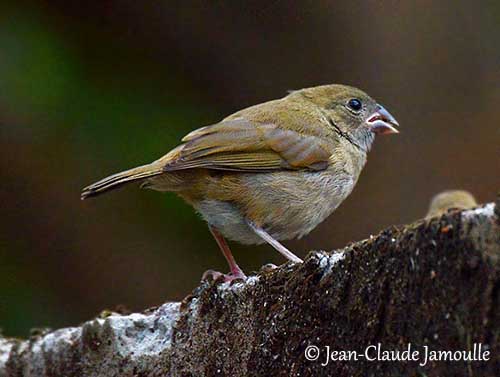
T.b. omissus
Juvenile
The female lays 2-5 white eggs with brownish markings. She incubates alone during 12 days. The chicks are fed by both parents. They fledge between 9 and 12 days after hatching.
The adults often produce a replacement clutch if the first brood is lost. Usually, they produce two broods per season.
PROTECTION / THREATS / STATUS:
The Black-faced Grassquit can be common in suitable habitat, and fairly common or rare (in Cuba) depending on the range.
The population is suggested to be increasing with the creation of new suitable areas, due to habitat degradation.
Currently, the Black-faced Grassquit is evaluated as Least Concern.